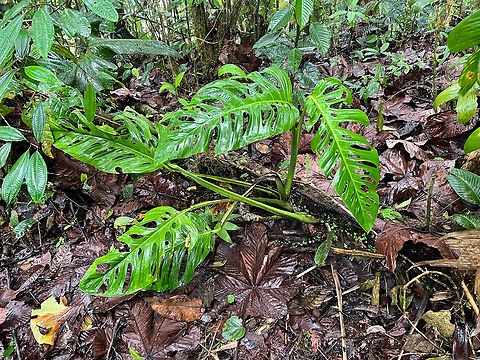
Appearance
This member of the arum family is a hemiepiphyte with aerial roots. It is able to grow up to 20 m high in the wild, with large, leathery, glossy, pinnate, heart-shaped leaves 25–90 cm long by 25–75 cm broad. The leaves on young plants are smaller and entire with no lobes or holes, but soon produce lobed and fenestrate leaves as they grow. Although it can grow very tall in nature, it only measures between 2 and 3 m when grown indoors. The older the plant, the more the leaves are covered with its familiar large perforations.Wild seedlings grow towards the darkest area they can grow until they find a tree trunk, then start to grow up towards the light, creeping up the tree.
The inflorescence is adorned with a cream-white spathe of uniform, velvety appearance, covering, like a hood, a yellowish white spadix 10 to 15 cm high and about 3 cm in diameter. Flowers are self pollinating, containing both androecium and gynoecium. Since they contain both structures, this plant is able to self-pollinate.
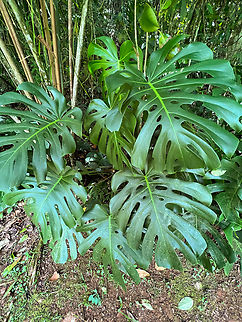
Naming
The specific epithet "deliciosa" means "delicious", referring to the edible fruit. The genus "Monstera" is named from the Latin word for "monstrous" or "abnormal", and refers to the unusual leaves with natural holes that members of the genus have.Its popular name as a houseplant of "Swiss cheese plant", or just "cheese plant", is commonly stated to refer to the "eyes" or holes which develop in its leaves similar to the holes in some Swiss-type cheeses such as Emmental cheese.
Other common names include delicious monster, fruit salad plant, fruit salad tree, ceriman, monster fruit, monsterio delicio, monstereo, Mexican breadfruit, windowleaf, balazo and Penglai banana. The names in Spanish, Portuguese, and French refer to the change of the leaves from entire to fenestrated, comparing it in the first two cases with the ribs of Adam and in the third with the hole-filled gruyère cheese, despite modern gruyère cheese having no holes. In Mexico, the plant is sometimes referred to as. In coastal regions of Sicily, especially Palermo, it is called "zampa di leone".
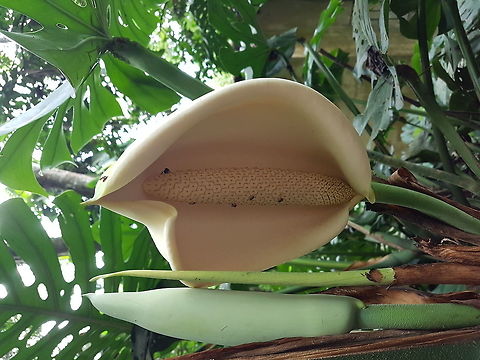
Distribution
This plant lives in the humid tropical forests, in the lowlands and middle mountains, in the extreme south of Mexico and also in Belize, Honduras, El Salvador, Costa Rica, Guatemala and Panama. The seeds fall to the ground, then the seedlings crawl until they meet a tree on which to attach. The many adjacent roots thus allow the plant to anchor against its new support and reach the canopy light. Wild plants can also be found in other parts of North America, Asia, Australia and the Western Mediterranean and Atlantic.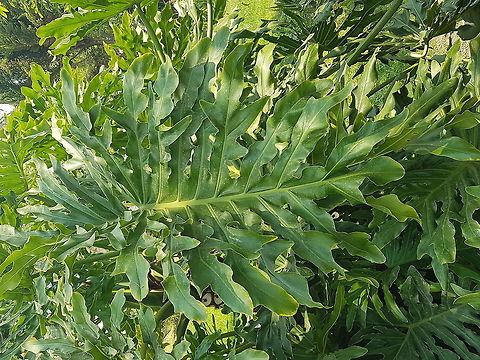
Defense
In those areas where it grows naturally, "M. deliciosa" is considered a delicacy due to its sweet and exotic flavor. The fruit may be ripened by cutting it when the first scales begin to lift up and it begins to exude a pungent odor. It is wrapped in a paper bag and set aside until the scales begin popping off. The scales are then brushed off or fall away to reveal the edible flesh underneath. The flesh, which is similar to pineapple in texture, can be cut away from the core and eaten. It has a fruity taste similar to jackfruit and pineapple. The unripe green fruits can irritate the throat and the latex of the leaves and vines can create rashes in the skin, because both contain potassium oxalate: that is the reason why the fruits have to be consumed when the scales lift up. The black irritant fibres can be swept off with the application of a little citrus juice.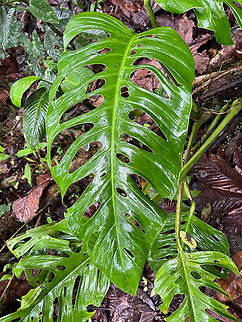
Uses
The aerial roots have been used as ropes in Peru, and to make baskets in Mexico. In Martinique the root is used to make a remedy for snakebite.References:
Some text fragments are auto parsed from Wikipedia.